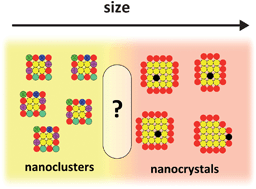On the nature and importance of the transition between molecules and nanocrystals: towards a chemistry of “nanoscale perfection”
Abstract
This paper discusses the importance of the transition between molecular compounds and

* Corresponding authors
a
Chemistry Department, Wilfrid Laurier University, 75 University Ave. W, Waterloo, Ontario, Canada
E-mail:
vkitaev@wlu.ca
b
Department of Chemistry and Chemical Biology, Harvard University, 12 Oxford Street, Cambridge, MA, USA
E-mail:
lcademartiri@gmwgroup.harvard.edu
This paper discusses the importance of the transition between molecular compounds and

 Please wait while we load your content...
Something went wrong. Try again?
Please wait while we load your content...
Something went wrong. Try again?
L. Cademartiri and V. Kitaev, Nanoscale, 2011, 3, 3435 DOI: 10.1039/C1NR10365B
To request permission to reproduce material from this article, please go to the Copyright Clearance Center request page.
If you are an author contributing to an RSC publication, you do not need to request permission provided correct acknowledgement is given.
If you are the author of this article, you do not need to request permission to reproduce figures and diagrams provided correct acknowledgement is given. If you want to reproduce the whole article in a third-party publication (excluding your thesis/dissertation for which permission is not required) please go to the Copyright Clearance Center request page.
Read more about how to correctly acknowledge RSC content.
 Fetching data from CrossRef.
Fetching data from CrossRef.
This may take some time to load.
Loading related content
